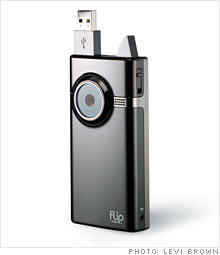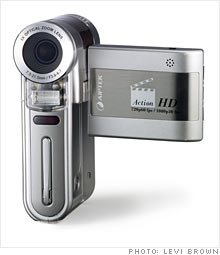Make your own HD movie
Need video in a hurry? These low-cost, pocket-size camcorders blew me away.

 |
| Flip Mino HD |
 |
| Aiptek Action HD |
SAN FRANCISCO (Fortune Small Business) -- The rise of high-definition video is good news for just about any small business. Whether you're promoting your new clothing line with clips from a fashion show or sending video progress reports of the house that you're building for a distant client, it's easier than ever to shoot breathtaking HD movies and upload them to the Web. (HD video has more than double the lines of a regular TV picture.)
I'm the CEO of Blinkx, the world's largest video search engine. To date we've indexed more than 32 million hours of TV on the Web. That means I watch a lot of video, and I can see how its quality is constantly improving.
I recently tested two new, low-cost HD camcorders. The Flip Mino HD ($230) is the latest in a line of highly successful digital camcorders that plug directly into your computer's USB port. Billed as the world's smallest camcorder, the Flip stands four inches tall and weighs about three ounces.
The Aiptek Action HD ($170) is roughly twice the size, with features to match. I travel a lot, so I was able to try out both cameras at home in San Francisco as well as on vacation in the U.K. and Mexico.
I started with the Aiptek. When I opened the box, a rat's nest of cords, connectors, plugs and accessories spilled onto the floor. But after browsing through the manual and playing around with the camera, I found the Aiptek quite easy to use. It ships with a tripod, a remote control and software that allows effortless movie editing and DVD creation. I was impressed with how much punch could be packed into a relatively small, inexpensive device. This camera is fantastic if you love gadgets and have the time and the inclination to tinker.
By contrast, the Flip was a breeze to operate right out of the box. Although it lacks the Aiptek's bells and whistles, the Flip has several features that grabbed my attention. It lets you send unlimited video e-mails, as well as upload your movies directly to YouTube, MySpace or AOL Video. And with its sleek black lines, the Flip wins hands down on the design front.
The Flip and the Aiptek store their movies digitally, rather than on tape. The Flip has a built-in hard drive with 4GB of memory, enough for about an hour of video. The Aiptek stores its images on SD cards, so you can get up to 8GB of storage (an 8GB SD card will cost you less than $30). And both cameras plug directly into your TV, showing off the HD to its best advantage.
The movies look great on a PC, as long as you have a relatively new model and are not running other programs at the same time. I run Windows XP on a Lenovo X300 laptop, and playing HD movies uses up 90% of the machine's processing power. One alternative is to burn the movies to a DVD. You can also upload video to the Web, but the movies have to be compressed, degrading their quality.
The Aiptek has a regular 3X optical zoom. The Flip has a 3X digital zoom, so its zoomed-in images are of lower quality. The two devices have good automatic exposure control. They did well in the Mexican sunshine and not too badly in the dim light of an English pub.
The Aiptek offers some useful focusing effects, such as the ability to blur the background behind an interview subject. Its dedicated indoor-light setting gave it a slight edge over the Flip in the pub, and its microphone is of better quality. The Flip carries only a short-range microphone - handy for narrating your own movies but no good for conducting interviews.
That said, my wife and I got more use out of the Flip. We are planning to renovate our 1970s-era apartment in San Francisco, and we used the camera to film "before" footage. The video turned out exactly as we'd hoped.
On vacation in Mexico, I attached the Flip to the front of a rented moped. With more serious hardware I could have strapped the Aiptek on as well, but the Flip was small enough that a couple of rubber bands did the trick. The resulting video came out insanely smooth, considering the bumpy ride. Finally, we took both cameras on a holiday visit to family and friends in the U.K., where I went everywhere with the Flip in the back pocket of my jeans. Two years ago, no HD camcorder would have fit there.
Now for my peeves about the Aiptek. You need to wrench open the rather flimsy viewing screen to turn it on. Unlike the Flip, which plugs straight into your computer and installs editing software directly from the camera, the Aiptek requires a separate USB cable, and you have to install the editing software from a CD. Given that my Lenovo laptop doesn't have a CD drive and I had to hunt around for an external one, this was a pain.
BOTTOM LINE: I care most about functionality, so though I was tempted by the Flip's portability and slim form, the bulkier but feature-rich Aiptek won by a mile. ![]()
-
The Cheesecake Factory created smaller portions to survive the downturn. Play
-
A breeder of award-winning marijuana seeds is following the money and heading to the U.S. More
-
Most small businesses die within five years, but Amish businesses have a survival rate north of 90%. More
-
The 10 most popular franchise brands over the past decade -- and their failure rates. More
-
These firms are the last left in America making iconic products now in their twilight. More











